Awakening
the second day in Osaka we were in for a surprise and treat. As it
turned out the day was a Japanese holiday and Nat was off work. Nat
would become our tour guide to Nara, the beautiful ancient (710 -
784 AD) capital and the cradle of its arts, crafts, literature and
industries. It was in Nara that Buddhism first appeared in Japan and
reached its peak in 752 when Diahutsu, the world's largest bronze
statue of Buddha, was completed in the Todaiji Temple.
The main hall of Todaiji Temple houses the Diahutsu and is known as
the world's largest wooden structure. Both the Diahutsu and the main
hall have been damaged or destroyed by fire numerous times since they
were first completed. The present statue dates to 1692 and the building
to 1709. |
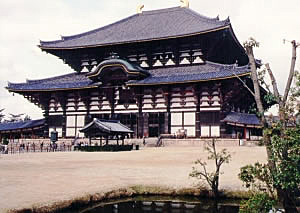 Todaiji
Temple Main Hall
Todaiji
Temple Main Hall |
|
|
|
|
|
|
|
|
|
|
|
|
|
|
|
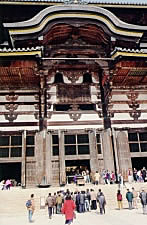 Entrance
to the main hall
Entrance
to the main hall
which houses the Diahutsu |
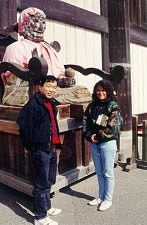 Nat
and Anne by the
Nat
and Anne by the
entrance |
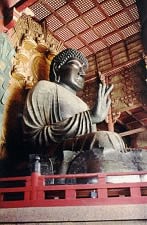 Diahutsu,
the world's
Diahutsu,
the world's
largest bronze statue of
Buddha |
|
|
|
|
|
|
|
|
|
|
|
|
|
|
|
|
|
|
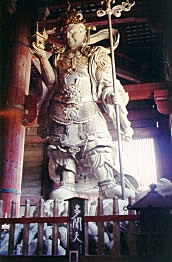 A
sentry standing guard
A
sentry standing guard
in the temple |
|
|
Diahutsu
is immense standing 53 feet high
and weighs 452 tons
|
|
|
|
|
|
|
|
|
|
|
|
|
|
|
|
|
|
|
|
|
|
|
|
|
|
|
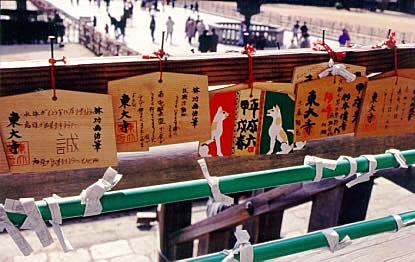 A
shrine devoted to animals
A
shrine devoted to animals |
|
|
|
|
|
|
|
|
|
|
|
|
|
|
|
|
The
Shrine above is a good example of the importance that the Japanese
place in their faith. The small wooden plaques and tied pieces of
paper contain messages from people. The message may be a request
for some favor to be granted or a thank you for a favor already
granted. Such small shrines appear everywhere throughout many of
the temple complexes. It also seems that these shrines are devoted
to particular aspects of life, such as the Love Shrine at Kiyomizu
Temple and this one to animals at Todaiji Temple.
Leaving
Todaiji Temple we proceeded into Nara Park, or what is commonly
referred to as Deer Park. There is a good reason for this as the
park contains over 1,000 tame deer that roam free within the confines
of the park. Being an animal lover this was one part of the day
I particularly enjoyed.
|
|
|
|
|
|
|
|
|
|
|
|
|
|
|
|
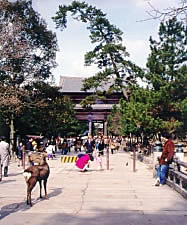
Entrance
to Kiyomizu Temple |
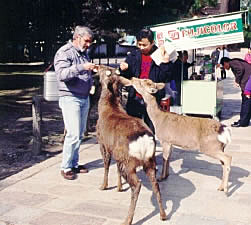
Feeding
the deer at Nara Park |
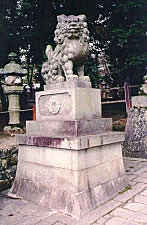 Statue
along the walk
Statue
along the walk |
|
|
|
|
|
|
|
|
|
|
|
|
|
|
|
|
Leaving
the grounds of Todaiji Temple and entering Deer Park you cross through
the barrier shown in the picture above left. On the temple side
of the barrier there was no sign of deer anywhere; on the other
side they were everywhere.
Nat
and I purchased food to feed the deer while Anne took our picture.
While tame, these deer can be a bit aggressive when there is food
to be had. A bit of advice: Don't place extra food in your back
pocket because the deer can smell it and will be nipping at your
pocket to get to the food. I know because I've been there and done
that!
|
|
|
|
|
|
|
|
|
|
|
|
|
|
|
|
|
|
After
an enjoyable few minutes feeding the deer Nat, Anne and I continued
down the walkways of Nara Park toward the Kasuga Grand Shrine.
Along the way we passed avenue after avenue lined with Japanese lanterns
and small statues. You could see little pieces of paper stuffed into
some of the cracks and crevices of the lanterns. Like the pieces of
paper tucked into the shrines these tiny pieces of paper contained
the same types of messages. |
|
|
|
|
|
|
|
|
|
|
|
|
|
|
|
| Kasuga
Grand Shrine is one of the most famous of the Shinto shrines in
all of Japan. Built in 768 the shrine is painted a bright vermilion
color over Japanese lacquered. Over 1,800 stone lanterns line the
shrine precinct and another 1,000 suspended from the eaves of the
corridors are the offerings of devotees to the deities enshrined.
Twice a year these lanterns are lit on the evenings of the Lantern
Festival. It must be a beautiful sight to behold. |
|
|
|
|
|
|
|
|
|
|
|
|
|
|
|
|
|
|
|
|
|
|
|
|
|
|
|
|
|
|
|
|
|
|
|
|
|
|
|
|
|
|
|
Leaving
Nara Park and heading to the car we passed yet another five-story
pagoda. Pagodas are found at virtually every temple we visited and
are common throughout Japan. Anne and I began to wonder what purpose,
if any, they served. Later that night, after returning to Nat and
Kako's, we looked up what a pagoda was and to our surprise we found
that they served mostly as decoration. They were not useful for storage
as there was very little room within them to store anything.
Leaving Nara we headed to our last stop of the day, Osaka Castle.
Osaka Castle should be familiar to you as it was seen in the film
Shogun many years ago. It is a beautiful castle nestled in
the center of bustling and modern Osaka. |
|
|
|
|
|
|
|
|
|
|
|
|
|
|
|
|
|
|
|
|
|
|
|
|
|
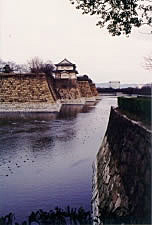 Moat
surrounding
Moat
surrounding
Osaka Castle |
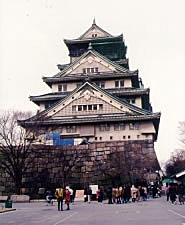 Osaka
Castle
Osaka
Castle |
|
|
|
|
|
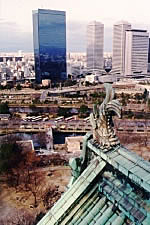 Osaka's
modern skyline
Osaka's
modern skyline
from Osaka Castle |
|
|
|
|
|
|
|
|
|
|
|
|
|
|
|
|
|
|
|
|
|
|
| The
history of Osaka Castle dates to 1496 when a small monk's lodge was
built nearby. By the late 1500's this lodge had grown into a rather
large temple, Ishiyama Honganji, and in 1580 the temple was surrendered
to Nobunaga Oda. Oda was attacked by a rival in 1582 and committed
suicide. Hideyoshi Toyotomi succeeded him and unified the country.
Hideyoshi built a magnificent castle, however, it was burned down
in 1615, 17 years after his death in the Summer Siege. Shogun Hidetada
Tokugawa took control of Osaka and in 1620 he began to rebuild Osaka
Castle completing it in 1629. By the mid-1800's many of the buildings
of Osaka Castle had burned down. In 1931 a restoration effort was
undertaken to rebuild Osaka Castle. During World War II many of the
smaller buildings were destroyed by bombing raids, but the magnificent
Osaka Castle survived in tact. Osaka Castle today houses an amazing
museum with many artifacts from Japan's ancient times. |
|
|
|
|
|
|
|
|
|
|
|
|
|
|
|
|
|
|
|
For
the next leg of our journey Anne and I would say good-bye to our good
friends and take the bullet train south to Hiroshima. Our goal in
Hiroshima was not to view the remnants of the destruction caused when
we dropped the atomic bomb, although I'm sure we'd see that as well,
rather it was to ring the Peace Bell in Peach Park. Something that
Anne and I hoped we could do. Join us on the next page to see what
happened on this our final day in Japan ... |
|
|
|
|
|
|
|
|
|
|
|
|
|
|
|
|





